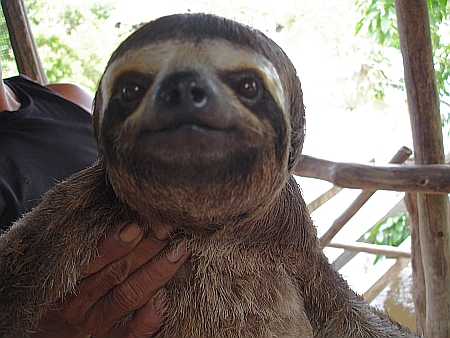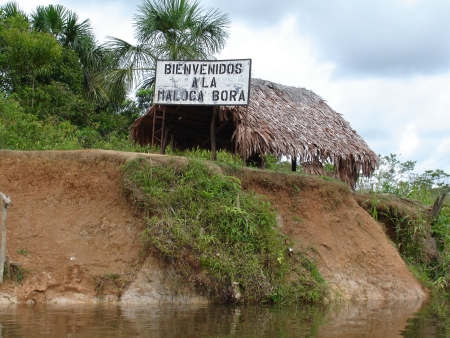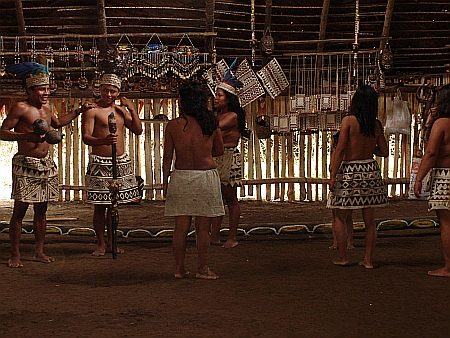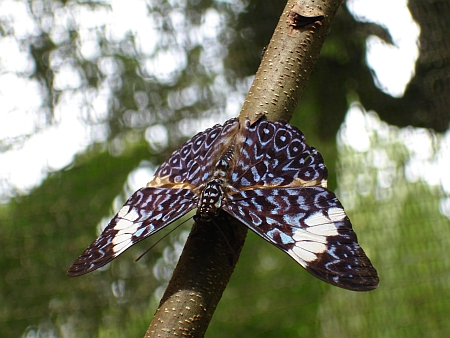OK the visit to the tourist info office was helpful this time. Basically you can do things in Iquitos or out in the jungle but having Iquitos as base camp.
In Iquitos you have -other than the city- Nanay, Quistococha and a Reserve on the road to Nauta.
I went to Nanay yesterday and got a boat to take me to the 4 main attractions around there: the serpentarium or snake house, the Boras, the Yaguas and the butterfly farm. It took close to 5 hrs due to the stuff you do, not to the time you spend traveling on the river. Some guys ask 60 to 80 soles, others say only 10 or 15 but in the middle of the river they tell you that it is only one way and that the whole trip will be double. Be sure to point out clearly that the agreed price includes the two-way trip and the visit to the 4 places -or the ones you want to visit- before you leave.
OK the snake house is like a small zoo that the same boat drivers say they’ve built to have a place where to take tourists and show the animals. I was told 10 soles was the entrance and the sign outside says 10 soles, but the guy there asked me 20 since I hadn’t come with an agency, he argued. I simply said the driver that we should continue as I can visit Quistococha zoo and see the animals there. Then the guardian agreed to charge me the stated fare.
They have like 10 different animals among monkeys, anaconda and mantona snakes, parrots, small crocodiles, añuje, and some small jungle birds. Also they let me carry the little smiling fellow you can see here.

He moves very very slowly and feels like a stuffed animal only with a stronger body. In a sense it would be a great pet. At the end of the visit they invite you to seat and bring a colorful parrot to stand in your arm and you get to taste clavohuasca or SVSS -seven times without pulling it out-. Yeah, they refer to that. Chatting a bit about his life there, the guardian remembered his time serving the army and the hardness he had to endure working in the jungle as a perro -first year soldier- and the conflict with Ecuador before arriving to settle and work there. Interesting story.
Then we left in order to reach the Boras. They don’t actually live there but come everyday in order to get in touch with tourists and get some income from admission tickets and the souvenirs they sell.

We danced a little, talked a little as well. Their language sounds a bit like Japanese. They told me they go back everyday to their community but that I could not go along as it may be dangerous to me, the path is not clear and currently underwater, parts of it are around 1.50 or 60 m deep but in that is possible to visit and stay at their community in the dry season.

I wanted to go as that should be a more real experience than they show they put up here.
Then we went to the Yaguas. The curaca welcomed me by painting my cheeks and chin with achote -a red bulb- and talked to me a little. They live very far from Iquitos, deep in the jungle. But an agency proposed them to come and 30 people agreed to move closer so that visitors could go and have a glimpse at their culture.
It was odd to see this man that looked like any guy in a shop or a corner dressed with a straw skirt, painted and half speaking Spanish. He did not get all I said in Spanish so I had to slow down and try simpler phrases. I had the same feeling than at the Boras. After dancing with them we seated and talked a while, even the women came closer and chatted a bit. We spoke of ayahuasca and their experiences with it, they offered me the possibility to try it but had to let them know a day ahead at least so they can contact a shaman. While talking to these half-naked women dressed in tree fiber skirts I thought that we are both Peruvians but differences in education and opportunities have made our experiences of what meant being a Peruvian so different. You cannot help feeling a little touched by how they live without so much that we take for granted.
Although the idea of progress or what progress could mean for us and for them can be a whole topic of discussion. And in that sense what better or best would be -occidentalize their culture? assimilate them in one of our large cities?- is also open to contrasting.
Finally we navigated to the butterfly farm.

I met two girls from Iquitos who had gotten a boat for 10 soles. On the way the driver said they wouldn’t go to the Yaguas and later that the price was one way and since they didn’t reach an agreement he left them at Padre Cocha -a village nearby- so they could look for another boat.
Anyhooo… the farm is well kept and maintained by a couple, an Austrian woman and her husband, a local who care after butterflies and many other animals, including monkeys, alligators, a jaguar, etc. Interesting to see so many animals and the owner provided a very good explanation of how butterflies are raised and grow, predators, species, etc. Sadly we just saw like 6 from the 40 varieties they have there and they moved a lot so getting them into pictures was harder than I though.

At the end the owner invited us soft drinks and gave us a pin as souvenir. They were out of t-shirts of my size. The way back was fast over a quiet river, so quiet as a black metal mirror that broke in waves as we moved along to reach the Nanay River. Simply navigating the rivers is such an amazing experience.
Almost 5 hours had gone by since we left so I invited the driver to have a menu and a couple of beers with me to chat a bit. You get 3 Cristal or Pilsen for s/10 Have yet to try the local beer, Iquiteña.
Julio, my boat driver, started talking about his time in the army. The army training -servicio militar- is welcome here and some guys enlist even before the minimum stated age as they do not have other means to obtain any sort of education. The army teaches them some discipline, personal defense and other skills that they value as well as provides home and shelter and a weekly payment -propina- that they can use for their expenses or to send their families. They also get relocated that means a bit of travel and the release of not being a burden any longer for their families or the single mother that raises them. Many of the good years for these guys refer to their adventures in the army and usually when they are discharged they get married or have kids and settle in a job to provide their families, just like Julio and the serpentarium guardian.
Talking and listening to these guys referring to their time in the army as the heyday of their lifes makes you think how different life can be.
Peru is so full of contrasts. In a good and bad way.
…
I saw a copy of the Iquitos Times. Seems to be a great resource.
Leave a reply to peregrinoinmovil Cancel reply